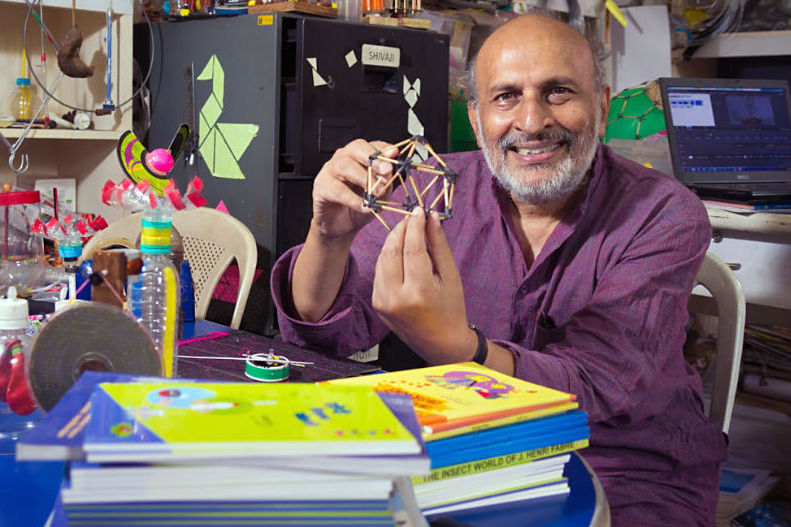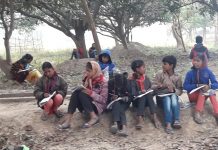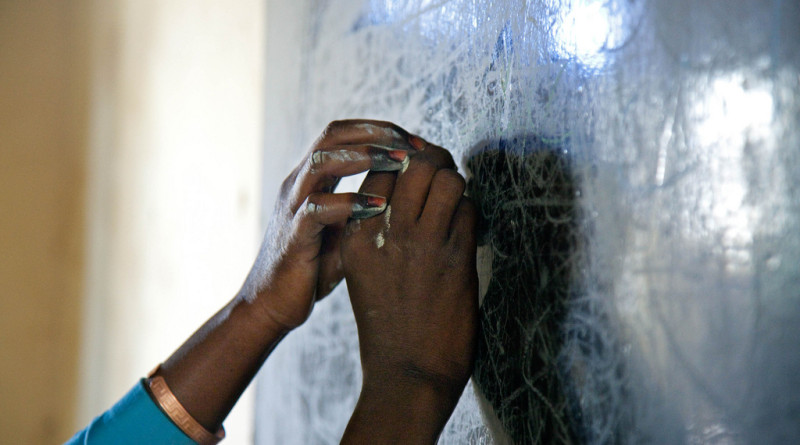The Art of Possibilities
A lifelong commitment to education and a passion for children mark Arvind Gupta’s fascinating story as an educator who has dedicated his life to innovative teaching through the creation of toys and tools with materials discarded as waste.
Here is an extract from an interview that editorial team conducted with him.

Mr. Gupta, your contributions to Science education are truly remarkable. Kindly share with us your intellectual trajectory: how you chose to take this path?
I joined IIT Kanpur in the year1970. In those days there was no school in IIT Kanpur for the children of mess servants, sweepers etc. So, some students with the help of a few progressive faculty members stared the Opportunity School. I would bunk classed once a week to teach in this school. In the 1970s many individuals were searching for a meaningful role for themselves.
The defining political slogan was: ‘GO TO THE PEOPLE, LOVE THEM, LIVE WITH THEM, START FROM WHAT THEY KNOW, BUILD ON WHAT THEY HAVE.’ It is with this spirit and passion that my journey began.
What is remarkable is your ability to arouse interest in science with simple toys, simple tools, and simple experiments. And this requires pedagogic imaginations, not money. Tell us something about the possibility of your project in a country like ours.
In the last 30 years I have visited over 3000 schools in various parts of the country. Most schools do not have a science lab. If it all it exists all the fancy plastic and glassware is locked in cupboards. Most of the equipment exists for the inspectors, not children. In the mid 70’s the Hoshangabad Science Teaching Programme (HSTP) started by Dr. Anil Sadgopal attempted to revitalize the teaching of science in village schools using local, low-cost material.
In 1978, I spent 6 months with the HSTP, and ever since that program has been my inspiration. Eleven years back I set up a website www.arvindguptatoys.com and started documenting simple science aids and toys in pictures, books and videos. Today we have 6700 videos in 20 languages with a viewership exceeding 46-million. There are still many challenges. We have failed to find partners to dub our videos in Oriya, Bangla, Nepali and some other languages. The website has 5,500 passionate books on education, science, environment, peace and world class children’s books. Every day 20,000 books are downloaded. It just shows the deep hunger for knowledge in our country with virtually no public libraries.
Recently the MHRD sponsored NROER (National Repository of Open Educational Resources) has uploaded 700 of our videos on their website. The prospect of a good educational website which provides free resources to teachers and learners in our country is tremendous.
There is a highly stratified pattern of schooling in our society: ‘elite schools’ versus ‘governmental schools’. What are the steps that we need to take to overcome this duality? Where do you see your contributions in this project?
Our country is highly stratified. The Kothari Commission way back in 1964 recommended “neighborhood schools”, where children from various socio-economic backgrounds could study together. This is the norm in most advanced Western Countries. But the political class in India subverted this idea. The organized Central Government employees have the Kendriya Vidyalayas (1300) where the government spends roughly Rs 35,000/- per child per year. For the aspiring rural cash crop entrepreneurs Rajiv Gandhi gave the gift of Navodaya Vidyalayas (one per district) where the government spends Rs 85,000/- per child per year. In Government and Municipal Schools where most of the poor children go the government spends a measly Rs 4000/- per child per year. The rich have no stake in the government schools. They have built gated, elite schools for their children. In my city of Pune there are half a dozen IB schools where the each child pays Rs 5 Lakhs per year. This is obscene!
These days, young students, tend to equate science with ‘entrance tests’ (for medical/engineering colleges) science. Is it really helping to create the inquiring spirit of science?
According to one estimate the Coaching Industry in India is worth 2,50,000 crores per annum!! In Kota – the Mecca of all coaching institutes over 30 aspiring students committed suicide last year! These sweat shops don’t make children clever – these are places which teach subjugation – first to the stupid teachers, the coaching institute sharks and then to the Indian state. Where is the free mind, which Rabindranath Tagore talked about? These sweat shops make mince meat of the student’s neurons – and leaves them with little originality and creativity.
What is the difference between ‘scientific temper’ and ‘technocratic consciousness’?
2500 years back the Buddha gave a very sound definition of scientific temper:
Believe nothing,
merely because you have been told to
Or because it is traditional
Or because you yourself have imagined it
Do not believe what your teacher tells you…
merely out of respect for the teacher
But whatever after due examination and
analysis you find, conducive to the good and
benefit, the welfare of all beings, that doctrine
believe and cling to and take it as your goal.
Scientific Temper is to question everything – included deep seated social norms.On the other hand Technocratic Consciousness claims to have a fix for every problem.They fail to see the political, social and economic structural linkages to poverty. They argue – increase consumption, increase pollution and then use technology to fix pollution.A wise Gandhi would say: LIVE SIMPLY SO THAT OTHERS MAY SIMPLY LIVE.
This article is published in The New Leam, April Issue( Vol.2 No.11).
The New Leam has no external source of funding. For retaining its uniqueness, its high quality, its distinctive philosophy we wish to reduce the degree of dependence on corporate funding. We believe that if individuals like you come forward and SUPPORT THIS ENDEAVOR can make the magazine self-reliant in a very innovative way.














